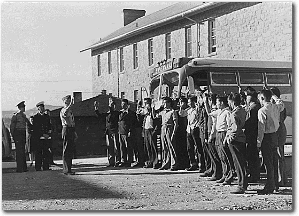
The Call Print Share
It is easy to forget what the world was like in the early 1940s. The United States was at war in Europe, and on December 7, 1941, we were faced with a second front as the Japanese Empire attacked Pearl Harbor.
One of the intelligence weapons the Japanese possessed was an elite group of well trained English speaking soldiers, used to intercept U.S. communications, then sabotage the message or issue false commands to ambush American troops. Military code became more and more complex – at Guadalcanal, military leaders complained that it took two and a half hours to send and decode a single message.
The use of Native American languages in coded military communications was not new to World War II; Choctaw Indians, for example were used as Code Talkers in World War I. The idea of using Navajo as code in World War II came from a veteran of World War I, Philip Johnston. Johnston, knowledgeable in the use of Native American languages during the first world war, knew of the military's search for a code that would withstand all attempts to decipher it. He was also the son of a missionary, raised on the Navajo reservation, spoke fluent Navajo, and believed Navajo answered the military requirement for an undecipherable code as it was an unwritten language of extreme complexity. After an impressive demonstration, the Marine Corps called upon the Navajo Nation to support the military effort by recruiting and enlisting Navajo men to serve as Marine Corps Radio Operators.
The "first twenty-nine," as they are sometimes referred to, are the first twenty-nine enlistees credited with the development of the original code, consisting of approximately 200 terms. It was designed to be short and concise and used or combined standard native words to create new terms for military hardware. But what proved to be most inventive, and confusing to the enemy, was the incorporation of an innovative alphabet to cover unforeseen contingencies. Using this method, the Navajo Code Talker could use distinctly different words for the exact same message, making the code extremely complex, but at the same time improving the speed of vital military communications. Due to its very flexibility, development of the code continued under subsequent Navajo Code Talkers, growing to over 600 terms. By the end of the war the Navajo code, and the very technique by which it was developed, became the most innovative, successful, and closely guarded military secret code of its time.
sometimes referred to, are the first twenty-nine enlistees credited with the development of the original code, consisting of approximately 200 terms. It was designed to be short and concise and used or combined standard native words to create new terms for military hardware. But what proved to be most inventive, and confusing to the enemy, was the incorporation of an innovative alphabet to cover unforeseen contingencies. Using this method, the Navajo Code Talker could use distinctly different words for the exact same message, making the code extremely complex, but at the same time improving the speed of vital military communications. Due to its very flexibility, development of the code continued under subsequent Navajo Code Talkers, growing to over 600 terms. By the end of the war the Navajo code, and the very technique by which it was developed, became the most innovative, successful, and closely guarded military secret code of its time.
Between the creation and the code's evolution is a distinction worthy of note. While all Navajo Code Talkers deserve recognition for their contribution to the code's use and continuing development, the original twenty-nine members gave birth to the idea, setting the standard for this living code.
Related Resources
The Navajo Code Talkers - Harrison Lapahie Jr.'s tribute to his father and the other Navajo code talkers.
National Archives: Philip Johnston letter describing the initial Navajo code demonstrations for the Commanding General of Amphibious Corps, Pacific Fleet, on February 27, 1942.